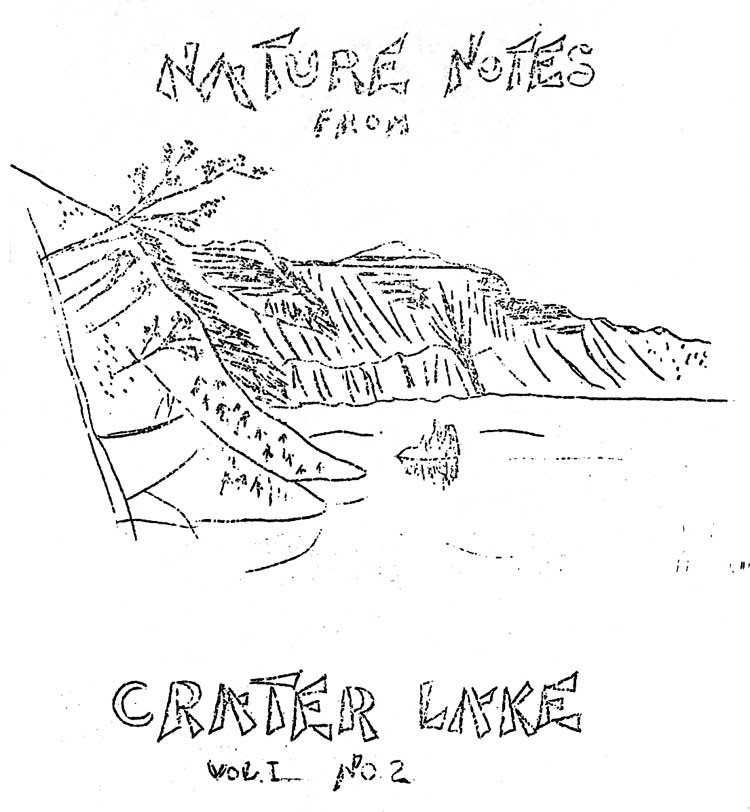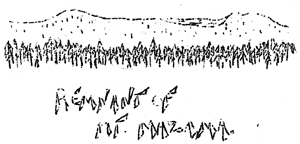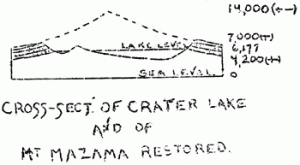Volume I No. 2 – August 1, 1928
All material courtesy of the National Park Service. These publications can also be found at http://npshistory.com/
Nature Notes is produced by the National Park Service. © 1928.
Crater Lake
By Earl U. Homuth
In the last issue of these notes, the evidences that a mountain did exist where Crater Lake now lies, were discussed.
What has become of Mt. Mazama ?
It may be claimed that no mountain existed and that the crater as it was now lies before us. But, other than the evidence that a mountain once existed is the fact that the walls of the caldera show cut edges of lava and are not coated or covered with a material which might have issued from this opening.
Two possibilities then remain: first, that a tremendous explosion removed the mass of the peak, or second, that the volcano fell in upon itself.
That terrific explosions did occur in the history of Mt. Mazama is evidenced by the pumice material found about the rim and the outlying region. However, as Diller points out in his paper “Geology of Crater Lake National Park” (Professional Paper No.3, Series B) this material is different from the material of the mass of the mountain judging that mass from the lava of the rim. Furthermore, the quantity thus removed would total approximately 17 cubic miles, which, if laid down three miles from the rim would give a layer a thousand feet thick. No such mass of material is present.
The remaining possibility is that the peak fell in upon itself. Had it fallen in as a solid mountain the displacement of the material at the base would have split the base completely assunder. The rim however, is not split; it is entire throughout its circumference. That the summit should fall into the neck of lava is possible, but offers no solution, since the amount of material would be just as great, although more of it now molten. That the lava of the volcano should escape through a radial vent, or a great fissure upon the lower slopes, thus draining the center remains as a final possible explanation.
Whether the entire column of lava escaped from one vent, or appeared at one point on the surface may be open to question. If the original mountain was equal to Shasta in height the column of lava totaled ten thousand feet, since the lake bottom is 4,200 feet above sea level. Furthermore, the material of the solid mountain must be accounted for, as having fallen into the resulting crater, when the support of the original lava was withdrawn. This material would then also have been fused and withdrawn.
A difficulty in this theory lies in the fact that the lava which can be definitely claimed as having issued from Mt. Mazama has not been determined. The level of the final withdrawal could not be above the 4,200 foot contour since this is the level to which it receded in the caldera.
That the entire mass could have drained into some great subterranean cavity is also possible but rather dodges the issue.
Whatever the explanation, a caldera has resulted nearly three thousand feet deep from the lowest point on the rim to the bottom, and this in turn filled with a lake, two thousand feet deep at its deepest sounding.
The possible origin of the lake itself will be discussed in a future issue of these notes.
Hemlocks and Firs of Crater Lake
By F. Lyle Wynd
There occur in Western states two species of hemlocks, both of which are found near Crater Lake. The Western Hemlock (Tsuga heterophyla) is of rare occurrence in lower altitudes of the Park. This is the tree so common in Williamette Valley and other lower regions outside the Park boundaries. The remaining species, the Mountain Hemlock, or as often called, the Black Hemlock (Tsuga mertensiana) is found only in the higher altitudes. It forms beautiful pure stands about the Rim of Crater Lake.
The two trees may be distinguished by the fact that the cones of the former are very small, rarely exceeding one inch in length, while the cones of the Mountain Hemlock are usually between 2 and 3 inches in length. Also the tips of the young branches of Western Hemlock are fuzzy, while those of the Mountain Hemlock usually are smooth. The cones of Western Hemlock usually are found all over the tree, while on the Mountain Hemlock they are found in the upper branches only. Lumber derived from the lower form is not extensively used while that of the mountain type is coming into more common use.
The firs most common in the Crater Lake region are the Noble Fir, (Abies nobilis) the Alpine Fir (A. lasiocarpa) and White Fir (A. concolor).
The largest of these is the Noble Fir. It is often found in pure stands and is the only one found on the Rim, altho not common there. It may be distinguished by the conspicuous reflexed bracts of the cone.
The Alpine Fir is common below the Rim especially near Park Headquarters. It is slender and spirelike in form altho scarcely ever exceeding 100 feet in height. The bark is thin, and the tree is often killed by extreme of temperature. The bracts are long and pointed but shorter than the scales of the cone.
The White Fir is found near the South Entrance. The branches are longer than any of the other firs.
The bracts of the cone are similar to the preceding but are abruptly sharp pointed, and can in this way be distinguished.
More Bird Notes
By Earl U. Homuth
The nest of a Thurber’s Junco is reported by L. Wynd near the edge of Pumice Desert. It was on the ground under loose bark. The bird entered it through a hole, and from a distance gave the impression of being a rat. Investigation disclosed four fledgelings.
Grouse were reported found nesting on Grouse Hill.
Don Fisher, rim ranger, reports two bald eagles from Wizard Island. The birds were observed with binoculars by a party of three. One bird was again observed several days later, and evidently the pair have returned to nest upon the island, as is their yearly custom.
A spotted sandpiper, “teetered” on a rock not ten feet from the writer, near the Witch’s Pool on the island. The contrast of spots on a white breast was never more clearly seen. With its characteristic cry it then flew back to the water and bobbed about among the rocks. These birds are fairly common along the shores of Wizard Island.
A group of three, including our practical road engineers out on road location were so intrigued by a, “flock” of hummingbirds flashing about among the forest foliage, that the particular duties of the moment were forgotten, and, seated quietly on the hillside they spent a full half hour watching these birds. Several were seen to perch on the twigs of nearby bushes, and the typical “fighting” antics, darting about in pursuit of each other, often within inches of the watchers, provided a relaxation which was a pleasure and a study in itself.
Many blue birds were observed near the shore of Wizard Island.
The camp robbers have not yet appeared in numbers near the Rim. Juncos and Cassin Purple Finches are the birds most common at present.
Pests
By Earl U. Homuth
These as the proverb says of the poor, we always have with us. From time to time experts in white pine blister rust, watching and searching for their pet pest, pay us a visit during their travels but no infection has yet been found in this vicinity.
The bark beetle, however, which years ago played havoc in the north part of the park among the lodgepole pines (Pinus contorta) has made sporadic appearances elsewhere. Since most of the trees of the south Rim are hemlocks there is no worry in that respect. But a group of very picturesque old white bark pines on the rim near the Community House are doomed. They are marked for cutting to prevent spreading of this pest. The bark shows pitch tubes in places so thick that it might have been peppered with a shot gun. The trees serve very nicely as an outdoor laboratory for demonstration to those interested, and a bit of bark peeled off will disclose larvae in various stages of development. This particular school for elementary forestry will be closed this week, however, when the axe lays low these infected trees.
Flowers
By Earl U. Homuth
The large pink monkey flower (Mimulus lewisii) is at its height and forms beautiful gardens beside the lake trail. The wheat species (Mimulus langsdorfii) is also found in patches amid the others.
The honeysuckle bears beautiful orange berries, and the anemone now bears it “wooly” clusters of seed pods, often mistaken for flowers. They are tall, permitting the wind to reach the seed pods; while in bloom they were short thus protecting the flowers.
The mountain forms of flowers are now in seed, and those at present blooming are those growing in moist, damp places.
The large fire-weed (Epilobium spicatum) is in bloom, while the smaller forms have their seed pods.
Great areas of Coville’s “aster” (Eucephalus covelli) and fleabane (Erigeron sp.) are in bloom.
In the lower regions the lupines form a riot of color.
The flower exhibit in the Community House now numbers 81 identified species.
Food for Fish
By Earl U. Homuth
The question of proper and sufficient food for the fish in Crater Lake’s almost chemically pure waters is often discussed. Since the only drainage into the lake is the small precipitation which falls on the cliffs from the Rim to the shore, any food carried into the lake from that source would be negligible. That food in sufficient abundance does exist is evidenced by the fact that the fish caught are always in excellent condition.
In the few shallows along the base of the talus under Glacier Peak and The Watchman, thousands of tadpoles were recently again observed, and frogs of at least two species, and this is at least one source of abundant food supply.
Welcome Home!
By Earl U. Homuth
Jemima, who had been mourned by all because she had failed to reappear in her old haunts, is with us again, and everyone at headquarters is cheerful and happy once more. She has added two cubs to our bear population.
She first appeared on the evening of July 29th and came over to the cook-house alone, the cubs remaining beyond the nearby stream. On the following evening the cubs were formally introduced to the cook, and now the family will undoubtedly be regular evening visitors.
L. Wynd reports the bears living on grubs found in dead timbers on the north side of the lake. The bark is being torn from dead trees and logs. Also deer are reported as especially plentiful and in excellent condition. They are in beautiful velvet. They were observed in groups on Grouse Hill.
Chipmunk Epicureans
By C. L. Groghan
Entering a ranger’s tent, a chipmunk examined various boxes, cans and corners. Finally he selected a spot near the center of the floor and began digging. In a minute or two he found what on closer examination proved to be a small fungus of the puff-ball type. After the chipmunk had left, a piece of chocolate cake was placed in the hole and carefully covered. Sometime later the chipmunk reappeared and after a more thoro examination of the tent and contents came back to the place where he had found the mushroom. He set to work, and in a moment the cake was found, duly examined and very, very impolitely if not indignantly kicked aside, and the excavating continued. After some effort and delays caused by the tunnel caving in, it appeared with another small mushroom which was greedily eaten.
A few days later a young chipmunk was noticed carefully searching the road after each car had passed the registering station. After some dozen or more cars had registered and passed on, something was found and hastily carried to a vantage point and the meal was begun. It was interrupted by two more chipmunks after the same tidbit, tho after some maneuvering they were discouraged allowing the observer to get a good view of the object in question which proved to be a humming bird. It no doubt had been cooked to a turn by the heat of the radiator of the car with which it had in some manner come into contact.
Other pages in this section





